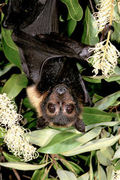
Logan and Albert Conservation Association

 The flying fox is at the forefront of many newspaper stories since the 2011 outbreak of Hendra. All horses that are tested positive are euthanized if they do not die of virus first. This is because of difficulty of keeping the large animal within required biosecurity framework.
The flying fox is at the forefront of many newspaper stories since the 2011 outbreak of Hendra. All horses that are tested positive are euthanized if they do not die of virus first. This is because of difficulty of keeping the large animal within required biosecurity framework.
While it is a tragedy to lose any human life ,4 of 7 people exposed to Hendra have died - all men, it is understood that Hendra cannot be transmitted directly from the bat to a human - the horse is needed as an intermediary for the human to contract the virus. Why are communities more upset about this possibilty than deaths on roads, death from air pollution, deaths from accidents in hospitals, deaths from coal mining accidents to name just some of many.
Do we assume that when humans cause death from accidents it is an unavoidable part of living in our society? We can contract may illnesses directly from animals such as cats, dogs, cows, pigs and more. These are called zoonoses. Zoonotic diseases can spread through a variety of means such as working closely with livestock, household pets, exhibited animals or wildlife, by coming in contact with soil or water contaminated by animals.
Practising good personal hygiene, wearing protective clothing, maintaining healthy animals and undertaking vaccination where appropriate, can minimise the risk of some animal-borne diseases infecting people.
DPI have information about protection of horses on their website here.
Flying foxes often visit properties where native eucalypts, bottlebrushes, lilly-pillies, figs and melaleucas are flowering. Blossoms are their primary source of food. They will also feed on palm seeds and exotic fruits when native food is less abundant.
Horse owners should follow these steps to reduce the risk of their horses becoming infected with Hendra virus:
Australian Bat Lyssavirus is caused by a bite or scratch from an infected bat. Carers pay over $200 of their own money to be vaccinated so they can care for injured / orphaned bats.
IT IS ESSENTIAL YOU DO NOT ATTEMPT TO CATCH OR MOVE FLYING FOXES / BATS UNLESS YOU HAVE BEEN VACCINATED.
You can read more about Zoonotic diseases at DPI website here.
A 300,000-strong bat colony is set to be "moved on” from Gayndah in the next five weeks – but where it will go, nobody knows. North Burnett Regional Council workers will start cutting branches from the trees where the animals roost in about five weeks time. It is a move that will pave the way for future flying fox colony relocations, with the Department of Environment and Resources pouring $40,000 into monitoring the impacts of dispersing the animals and the risk of spreading hendra virus. "We have to wait about five weeks until the little bats are able to fly before we move them on,” Mayor Joy Jensen said. "Where are these bats going to go? No one knows. But the permit has been granted for the full township of Gayndah so at least we know we can work on them until they leave.” Ms Jensen said residents were sick and tired of the bats, which not only posed a health risk but had caused "immeasurable” damage to the town’s riverbank since they arrived in September last year. A number of businesses had also been hit hard by the "smelly” and "noisy” colony, particularly the ones located along the river. "There has been no explanation as to why they’re in such large numbers. It’s an unbelievable sight to see that many bats hanging in so few trees,” Ms Jensen said. Anyone who couldn’t understand why residents were so distressed should come and have a look for themselves, Ms Jensen said. "It hasn’t been a pleasant situation and it’s driven a lot of people to say and threaten to do a lot of things they wouldn’t consider under normal circumstances. "Residents feel the bats were given priority over them.” *Fraser Coast Chronicle